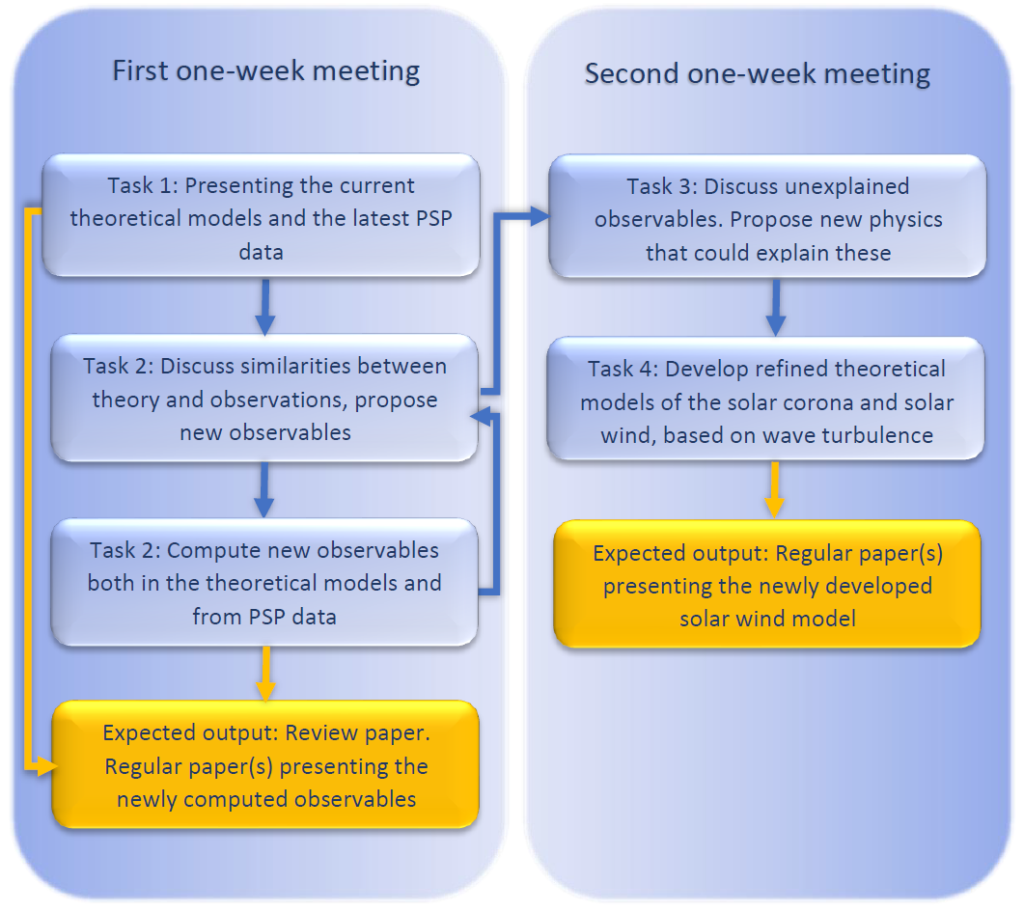The work plan for the proposed meetings is the following: In the first task, the invited team
members that authored the different theoretical models of the solar wind will present observables
that their theory predicts, and that can be compared to data obtained by the Parker Solar Probe. The
team members were carefully selected in order to have a full representation of the different schools
of thought and approaches to theoretical solar wind modelling. The incompressible and reduced-
MHD models are presented by Dr. Asgari-Targhi and Dr. Verdini, the nearly incompressible model is
presented by Dr. Laxman, the compressible model based on the parametric decay is presented by Dr.
Shoda, and the inhomogeneous compressible models are presented by Dr. Van Doorsselaere, Prof.
Hillier, and Dr. Magyar. The related works are cited throughout the scientific rationale. In
parallel, team members specialized in observational analysis (Dr. Bandyopadhyay, Dr. Chen, Dr.
D’Amicis, and Dr. Szabo) will present the latest results of the in-situ measurements in the solar wind.
Specific scientific objectives are the determination of the properties of solar wind turbulence near
the critical Alfvén point and establishing whether these properties are different from those found in
the sub- and super-Alfvénic wind, based on Parker Solar Probe in-situ data. These properties of the
solar wind are the perpendicular and parallel magnetic field, velocity, density, and energy spectra,
magnitudes of Elsässer variables, cross-helicity, Alfvénicity, compressibility.
In the second task, similarities between theoretical predictions and measurements will be
discussed in open discussion session. Additionally, derived quantities that can be compared between
theoretical models and observations will be proposed, in an iterative, refining process. These derived
quantities might include different statistical correlations between velocity, magnetic field, Elsässer
variable perturbations and total magnetic field, background density, Alfvén speed values and
gradients, nonlinear advective terms, etc. Specific scientific objectives are determining which
theoretical models (incompressible, nearly-incompressible, compressible) explain best the
observables established in the first task, and the calculation of the derived quantities and their
comparison between theoretical models and observed values.
In the third task, observational evidence that cannot be explained by the available models will be
discussed, along the required physics that is missing from the present models but might explain the
experimental findings. Specific scientific objectives are the determination of properties of the solar
wind turbulence that are currently not explained by any of the presented models, and the
identification of physical phenomena that might explain these properties.
In the fourth task, the team will lay the foundations for the development of new, refined
theoretical models of the solar corona and solar wind based on wave turbulence, that could explain
the yet unexplained properties of the solar wind, determined in the third task. Specific scientific
objectives are the determination of the details of analytical and/or numerical models for an updated
solar coronal and solar wind model, including the required physics, methods, and analysis, and
devising a work plan for carrying out the construction of the model.
Below you will find a schematic representation of the proposed project workplan:


